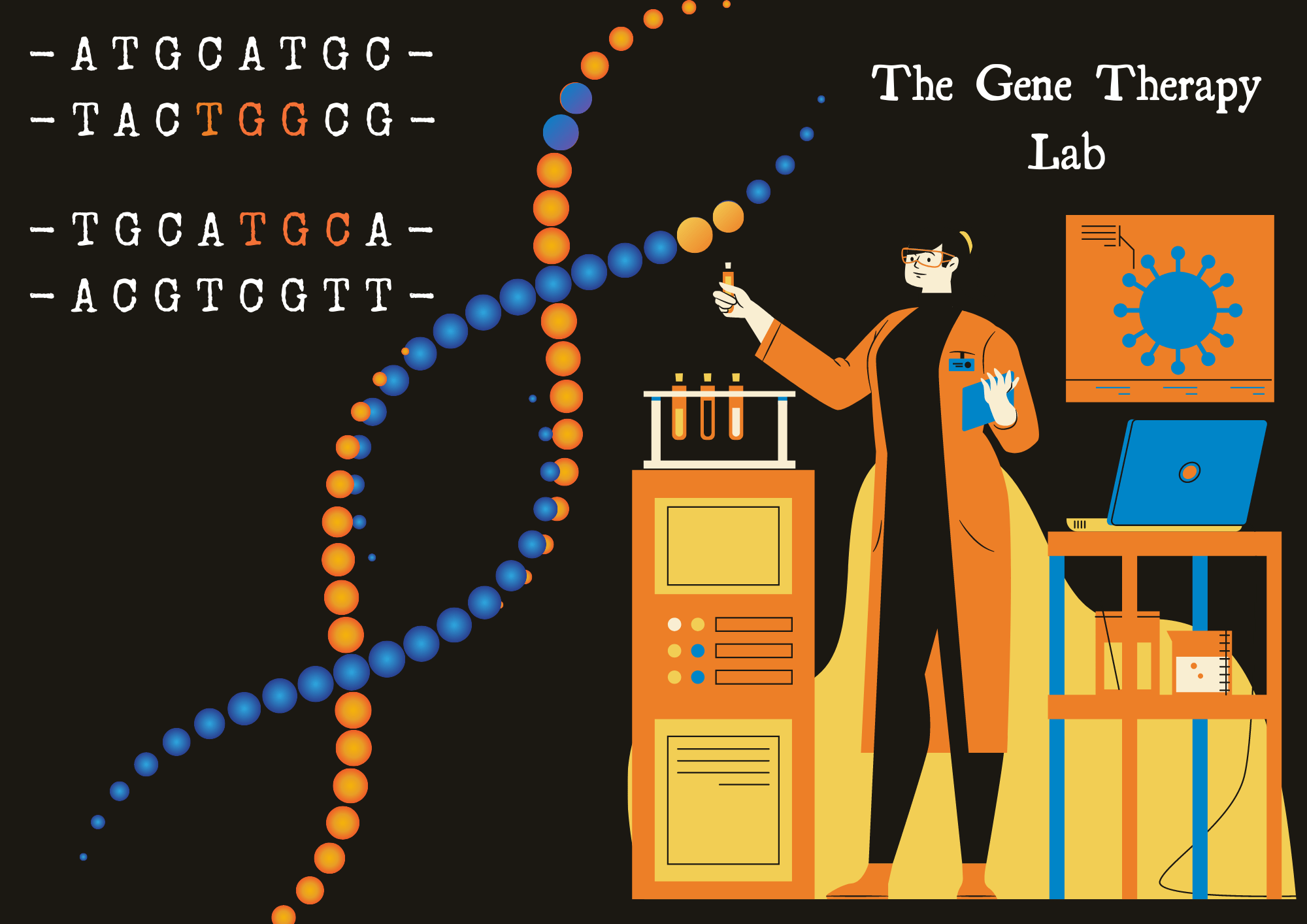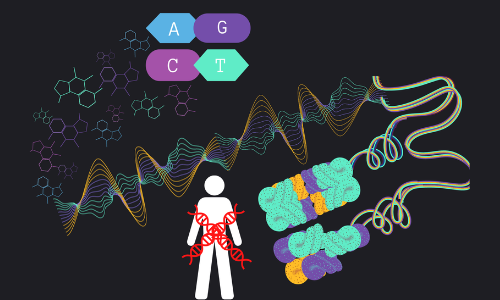When one thinks about diseases, usually infectious diseases come to mind. Especially after the SARS – CoV – 2 pandemic in which a pathogenic virus was responsible for the disease!
However, a large portion of human diseases can be categorized as genetic disorders! What are genetic disorders? These are diseases which are inherited and tend to run in families from one generation to the next. They are caused by abnormalities which arise in the human genome.
What exactly is a genome? The term “genome” is used by scientists to refer to all of the genetic information contained within a cell. It includes the genes, i.e., the coding regions and the noncoding DNA on the 23 pairs of chromosomes, as well as the mitochondrial DNA in the human cell.
Although rare, more than 6,000 genetic disorders are currently known! Additionally, new genetic disorders are constantly being described in medical literature. Genetic disorders can be divided into three main categories: single – gene, multifactorial and chromosomal disorders.

Single – Gene Disorders:
Single – gene disorders are also known as monogenic disorders. They are caused by a single mutated gene. This mutated gene may be present on any of the 46 human chromosomes.
Consequently, a single – gene disorder may be divided into an autosomal, an X – linked or a Y – linked disease. Based on the pattern of inheritance and their expression, a single – gene disorder may be described as dominant or recessive in nature. This means that single – gene disorders can be specified as autosomal dominant, autosomal recessive, X – linked dominant, X – linked recessive and Y – linked (there’s no such thing as dominant and recessive in the case of the Y – linked gene disorders). For example, sickle – cell anaemia is a monogenic disorder. Specifically, it is an autosomal recessive disorder. On the flip side, Huntington’s disease is an autosomal dominant disorder.
Although X – linked dominant disorders are quite few in number, X – linked hypophosphatemic rickets is the best example. On the other hand, X – linked recessive disorders include haemophilia A, Duchenne muscular dystrophy, and Lesch – Nyhan syndrome, as well as red – green colour blindness. Lastly, Y – linked disorders are the rarest of them all and are caused due to mutations on the Y chromosome. They are only restricted to males (since only males possess the Y chromosome). The most well – known examples typically cause infertility in males.

Human Chromosomes and Genetic Disorders
Illustration Source: Petkov, Igor. “Human Chromosome Diseases Set.” Wikipedia, Wikimedia Commona, 2017, https://en.wikipedia.org/wiki/File:Human_chromosome_diseases_set_en.svg. Accessed 2022.
Multifactorial Genetic Disorders:
What if genetic disorders are caused by more than one gene? That’s exactly what multifactorial genetic disorders are! These are also known as complex or polygenic genetic disorders. The development of these disorders can be attributed to the inheritance of multiple genes along with lifestyle and environmental factors. As there is no distinct pattern of inheritance, an individual’s risk of developing such a disorder is quite unpredictable. These diseases do not fit into the well – known Mendelian pattern of inheritance as well. The answer might still be hidden within our genome, yet to be discovered through further research by scientists! However, it is established that these diseases tend to “run in families” and can be traced by pedigree analysis.
What exactly is “pedigree analysis”? A pedigree is basically a family tree for genes! Scientists can use pedigrees to determine genotypes, identify phenotypes, and predict how a disease trait will be passed on to the future generations. Approaches to study, identify, and treat such diseases include determining genotype –phenotype associations. Studies involving multifactorial genetic disorders include the modern genotype – first approach and the traditional phenotype – first approach. For example, diabetes, heart disease, autoimmune diseases, asthma, inflammatory bowel disease, hypertension, cleft disease, infertility, etc. may be classified as complex genetic disorders.

Pedigree Analysis
Chromosomal Disorders:
Let’s move onto the third and last category of genetic disorders! Remember how the 23 pairs of chromosomes in the human genome were mentioned above? What if there is a fault in the chromosomes and not in the genes? So, we reach upon chromosomal disorders! Chromosomal disorders are caused by an abnormality in the human chromosomes. This irregularity may be in the form of an atypical number or a structural abnormality.
This means that the number of chromosomes may differ and lead to the diseased condition or there might be some abnormal structure found amongst the chromosomes. For example, Down syndrome is an example of a chromosomal disorder. In Down syndrome, an individual inherits an additional 21st chromosome in addition to the normal set of 46 chromosomes. Hence, trisomy 21 is another name for Down syndrome.
Mitochondrial Diseases:
Now that we have basically covered the three categories of genetic disorders, let’s shift gears and bring mitochondrial diseases into the picture! Remember the definition of “genome” above? For the human cell, the genome includes the mitochondrial DNA. So, wouldn’t an abnormality in the mitochondrial DNA contribute towards the development of a genetic disorder as well? Certainly!
Mitochondrial diseases are the diseases in which there is mitochondrial dysfunction. This dysfunction may arise due to mutations in the nuclear DNA encoding for important mitochondrial components or due to mutations within the DNA of the mitochondria, themselves! The mitochondrial DNA encodes 13 genes. The genes of the mitochondria follow a pattern of inheritance known as maternal inheritance. “Maternal inheritance” refers to the form of inheritance in which only the mother can pass the mitochondrial DNA to her offspring. This is because only the egg cell mitochondria (and not the sperm cell mitochondria) are passed to the developing embryo. An example of a mitochondrial disease is Leber’s hereditary optic neuropathy. It is passed onto the next generation from the mother, as it is primarily due to mutations in the mitochondrial genome,
However, once again, it should be noted! Many of the mitochondrial diseases are actually caused by defects in nuclear genes encoding for important mitochondrial components. So, although they are mitochondrial diseases, these diseases mostly follow autosomal recessive inheritance and not the maternal pattern of inheritance.
Diagnosis and Treatment:
As already mentioned above, there is a genetic basis for the diagnosis of genetic disorders. However, there is a great variation in the diagnosis of genetic disorders. Although most genetic disorders can be diagnosed pre – birth, at birth, or during early childhood, some can evade detection until the patient has entered adulthood. Prenatal diagnosis, pedigree analysis, and medical intervention for potential lifestyle changes are the few precautionary measures that can possibly contribute towards the diagnosis and the prevention of the development of genetic disorders in the future generations.
As for the treatment of genetic disorders, gene – therapy is the primary treatment option. Gene therapy is the treatment of a genetic disorder by introducing the healthy gene into the patient to function in place of the faulty gene.

Treatment of Genetic Disorders by Gene Therapy
For targeting specific genetic disorders, a large number of gene therapy clinical trials having been completed, are ongoing, or have been approved worldwide. However, treatment is largely hindered by the investigation of an appropriate method to introduce a gene into the potentially trillions of cells in the patient’s body that carry the defective gene copy.
How exactly will scientists bridge this gap between finding the gene or genes responsible for a specific genetic disorder and correcting that genetic disorder in the years to come? That’s the million – dollar question in the future of genetic disorders and gene therapy, today!
References:
- “Genetic Disorder.” Wikipedia, Wikimedia Foundation, 7 Apr. 2022, https://en.wikipedia.org/wiki/Genetic_disorder#Chromosomal_disorder.
- “Genetic Disorders.” Genome.gov, https://www.genome.gov/For-Patients-and-Families/Genetic-Disorders.
- “Genetic Disorders.” Learn Genetics, Genetic Science Learning Center, https://learn.genetics.utah.edu/content/disorders/.
- “Genetic Disorders: What Are They, Types, Symptoms & Causes.” Cleveland Clinic, 20 Aug. 2021, https://my.clevelandclinic.org/health/diseases/21751-genetic-disorders.
- Taylor, Robert B., et al. “Chapter 3 Genetic Disorders.” Taylor’s Diagnostic and Therapeutic Challenges: A Handbook, Springer, New York, NY, 2005, pp. 35–53.
Writer
Shivani Havaldar
Editor
Ketan Kulkarni
Illustrator
Anushree Krishnamurthy

